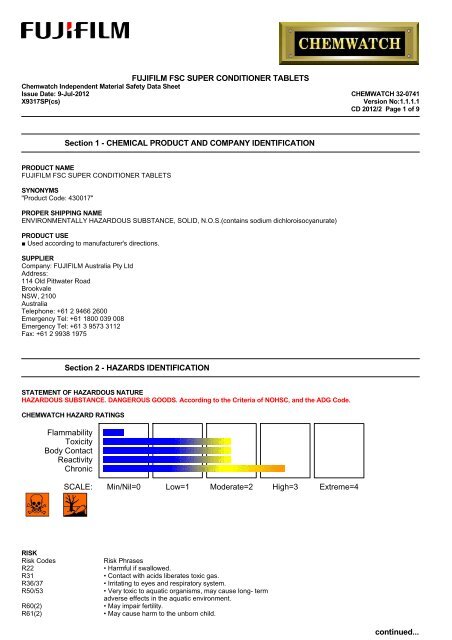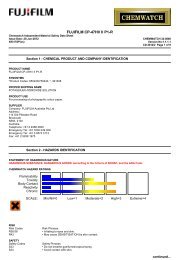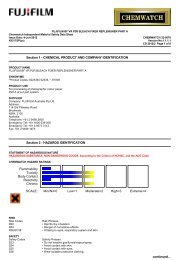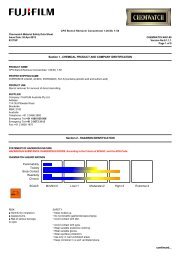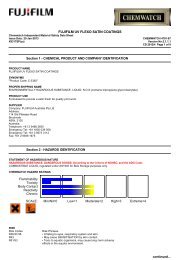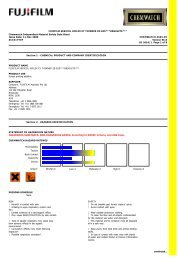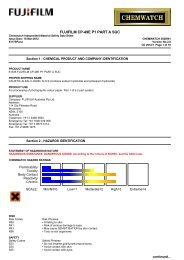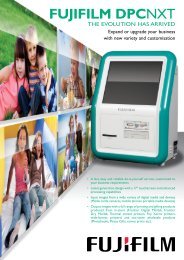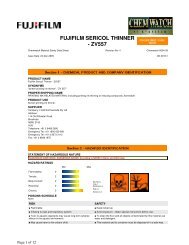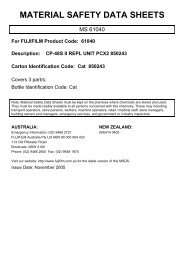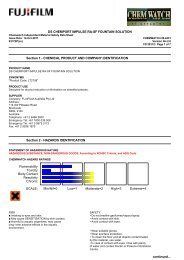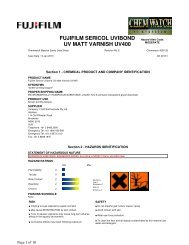Chemwatch Australian MSDS 32-0741 - FUJIFILM Australia
Chemwatch Australian MSDS 32-0741 - FUJIFILM Australia
Chemwatch Australian MSDS 32-0741 - FUJIFILM Australia
You also want an ePaper? Increase the reach of your titles
YUMPU automatically turns print PDFs into web optimized ePapers that Google loves.
<strong>FUJIFILM</strong> FSC SUPER CONDITIONER TABLETS<strong>Chemwatch</strong> Independent Material Safety Data SheetIssue Date: 9-Jul-2012 CHEMWATCH <strong>32</strong>-<strong>0741</strong>X9317SP(cs)Version No:1.1.1.1CD 2012/2 Page 1 of 9Section 1 - CHEMICAL PRODUCT AND COMPANY IDENTIFICATIONPRODUCT NAME<strong>FUJIFILM</strong> FSC SUPER CONDITIONER TABLETSSYNONYMS"Product Code: 430017"PROPER SHIPPING NAMEENVIRONMENTALLY HAZARDOUS SUBSTANCE, SOLID, N.O.S.(contains sodium dichloroisocyanurate)PRODUCT USE■ Used according to manufacturer's directions.SUPPLIERCompany: <strong>FUJIFILM</strong> <strong>Australia</strong> Pty LtdAddress:114 Old Pittwater RoadBrookvaleNSW, 2100<strong>Australia</strong>Telephone: +61 2 9466 2600Emergency Tel: +61 1800 039 008Emergency Tel: +61 3 9573 3112Fax: +61 2 9938 1975Section 2 - HAZARDS IDENTIFICATIONSTATEMENT OF HAZARDOUS NATUREHAZARDOUS SUBSTANCE. DANGEROUS GOODS. According to the Criteria of NOHSC, and the ADG Code.CHEMWATCH HAZARD RATINGSFlammabilityToxicityBody ContactReactivityChronicSCALE: Min/Nil=0 Low=1 Moderate=2 High=3 Extreme=4RISKRisk CodesRisk PhrasesR22• Harmful if swallowed.R31• Contact with acids liberates toxic gas.R36/37 • Irritating to eyes and respiratory system.R50/53 • Very toxic to aquatic organisms, may cause long- termadverse effects in the aquatic environment.R60(2)• May impair fertility.R61(2)• May cause harm to the unborn child.continued...
<strong>FUJIFILM</strong> FSC SUPER CONDITIONER TABLETS<strong>Chemwatch</strong> Independent Material Safety Data SheetIssue Date: 9-Jul-2012 CHEMWATCH <strong>32</strong>-<strong>0741</strong>X9317SP(cs)Version No:1.1.1.1CD 2012/2 Page 2 of 9Section 2 - HAZARDS IDENTIFICATIONSAFETYSafety CodesS01S24S25S36S38S37S39S53S29S40S35S13S26S57S61S60Safety Phrases• Keep locked up.• Avoid contact with skin.• Avoid contact with eyes.• Wear suitable protective clothing.• In case of insufficient ventilation, wear suitable respiratory equipment.• Wear suitable gloves.• Wear eye/face protection.• Avoid exposure - obtain special instructions before use.• Do not empty into drains.• To clean the floor and all objects contaminated by this material, use water.• This material and its container must be disposed of in a safe way.• Keep away from food, drink and animal feeding stuffs.• In case of contact with eyes, rinse with plenty of water and contact Doctor orPoisons Information Centre.• Use appropriate container to avoid environmental contamination.• Avoid release to the environment. Refer to special instructions/Safety datasheets.• This material and its container must be disposed of as hazardous waste.Section 3 - COMPOSITION / INFORMATION ON INGREDIENTSNAME CAS RN %sodium sulfate 7757-82-6 70-90sodium dichloroisocyanurate 2893-78-9 10-20boric acid 10043-35-3 1-5Section 4 - FIRST AID MEASURESSWALLOWED• IF SWALLOWED, REFER FOR MEDICAL ATTENTION, WHERE POSSIBLE, WITHOUT DELAY.• For advice, contact a Poisons Information Centre or a doctor.• Urgent hospital treatment is likely to be needed.• In the mean time, qualified first-aid personnel should treat the patient following observation and employing supportivemeasures as indicated by the patient's condition.EYE• Generally not applicable.SKIN■ If skin contact occurs:• Immediately remove all contaminated clothing, including footwear.• Flush skin and hair with running water (and soap if available).• Seek medical attention in event of irritation.INHALED• If fumes or combustion products are inhaled remove from contaminated area.• Lay patient down. Keep warm and rested.• Prostheses such as false teeth, which may block airway, should be removed, where possible, prior to initiating first aidprocedures.• Apply artificial respiration if not breathing, preferably with a demand valve resuscitator, bag-valve mask device, or pocketmask as trained. Perform CPR if necessary.• Inhalation of vapours or aerosols (mists, fumes) may cause lung oedema.• Corrosive substances may cause lung damage (e.g. lung oedema, fluid in the lungs).• As this reaction may be delayed up to 24 hours after exposure, affected individuals need complete rest (preferably in semirecumbentposture) and must be kept under medical observation even if no symptoms are (yet) manifested.• Before any such manifestation, the administration of a spray containing a dexamethasone derivative or beclomethasone derivativemay be considered.NOTES TO PHYSICIAN■ Treat symptomatically.Excellent warning properties force rapid escape of personnel from chlorine vapour thus most inhalations are mild to moderate. Ifescape is not possible, exposure to high concentrations for a very short time can result in dyspnea, haemophysis and cyanosiswith later complications being tracheobroncho-pneumonitis and pulmonary oedema.Depending on the degree of exposure, periodic medical examination is indicated. The symptoms of lung oedema often do not manifestuntil a few hours have passed and they are aggravated by physical effort.continued...
<strong>FUJIFILM</strong> FSC SUPER CONDITIONER TABLETS<strong>Chemwatch</strong> Independent Material Safety Data SheetIssue Date: 9-Jul-2012 CHEMWATCH <strong>32</strong>-<strong>0741</strong>X9317SP(cs)Version No:1.1.1.1CD 2012/2 Page 3 of 9Section 4 - FIRST AID MEASURESSection 5 - FIRE FIGHTING MEASURESEXTINGUISHING MEDIA• Water spray or fog.• Foam.• Dry chemical powder.• BCF (where regulations permit).FIRE FIGHTING• Alert Fire Brigade and tell them location and nature of hazard.• Wear breathing apparatus plus protective gloves in the event of a fire.• Prevent, by any means available, spillage from entering drains or water courses.• Use fire fighting procedures suitable for surrounding area.Slight hazard when exposed to heat, flame and oxidisers.FIRE/EXPLOSION HAZARD• Non combustible.• Not considered a significant fire risk, however containers may burn.Decomposition may produce toxic fumes of: carbon dioxide (CO2), hydrogen chloride, phosgene, nitrogen oxides (NOx), sulfur oxides(SOx), other pyrolysis products typical of burning organic material.FIRE INCOMPATIBILITY• Avoid contamination with oxidising agents i.e. nitrates, oxidising acids, chlorine bleaches, pool chlorine etc. as ignition mayresult.HAZCHEM2ZSection 6 - ACCIDENTAL RELEASE MEASURESMINOR SPILLS■ Environmental hazard - contain spillage.• Clean up all spills immediately.• Secure load if safe to do so.• Bundle/collect recoverable product.• Collect remaining material in containers with covers for disposal.MAJOR SPILLS■ Environmental hazard - contain spillage.• Clean up all spills immediately.• Wear protective clothing, safety glasses, dust mask, gloves.• Secure load if safe to do so. Bundle/collect recoverable product.• Use dry clean up procedures and avoid generating dust.Personal Protective Equipment advice is contained in Section 8 of the <strong>MSDS</strong>.Section 7 - HANDLING AND STORAGEPROCEDURE FOR HANDLING• Avoid all personal contact, including inhalation.• Wear protective clothing when risk of exposure occurs.• Use in a well-ventilated area.• Prevent concentration in hollows and sumps.SUITABLE CONTAINER• Glass container is suitable for laboratory quantities.• Polyethylene or polypropylene container.• Packing as recommended by manufacturer.• Check all containers are clearly labelled and free from leaks.STORAGE INCOMPATIBILITY• Contact with acids produces toxic fumes.continued...
<strong>FUJIFILM</strong> FSC SUPER CONDITIONER TABLETS<strong>Chemwatch</strong> Independent Material Safety Data SheetIssue Date: 9-Jul-2012 CHEMWATCH <strong>32</strong>-<strong>0741</strong>X9317SP(cs)Version No:1.1.1.1CD 2012/2 Page 4 of 9Section 7 - HANDLING AND STORAGE• Avoid any contamination of this material as it is very reactive and any contamination is potentially hazardous.• Avoid storage with reducing agents.• Segregate from alcohol, water.Avoid storage of dichloroisocyanurates with ammonia, urea or similar nitrogen containing compounds, inorganic reducing compounds,calcium hypochlorite, alkalis and water.Corrosive to most metals in the presence of moisture.• Many compounds containing more than one N-halogen bond are unstable and exhibit explosive properties.BRETHERICK L.: Handbook of Reactive Chemical Hazards.• Avoid strong bases.STORAGE REQUIREMENTS• Material is hygroscopic, i.e. absorbs moisture from the air. Keep containers well sealed in storage.• Store in original containers.• Keep containers securely sealed.• Store in a cool, dry, well-ventilated area.• Store away from incompatible materials and foodstuff containers.Store away from incompatible materials.Section 8 - EXPOSURE CONTROLS / PERSONAL PROTECTIONEXPOSURE CONTROLSThe following materials had no OELs on our records• sodium sulfate: CAS:7757- 82- 6• sodium dichloroisocyanurate: CAS:2893- 78- 9• boric acid: CAS:10043- 35- 3 CAS:11113- 50- 1 CAS:41685- 84- 1MATERIAL DATABORIC ACID:SODIUM SULFATE:■ It is the goal of the ACGIH (and other Agencies) to recommend TLVs (or their equivalent) for all substances for which thereis evidence of health effects at airborne concentrations encountered in the workplace.At this time no TLV has been established, even though this material may produce adverse health effects (as evidenced in animalexperiments or clinical experience).NOTE: The ACGIH occupational exposure standard for Particles Not Otherwise Specified (P.N.O.S) does NOT apply.<strong>FUJIFILM</strong> FSC SUPER CONDITIONER TABLETS:SODIUM DICHLOROISOCYANURATE:■ for chlorine:Odour Threshold Value: 0.08 ppm (detection) - olfactory fatigue may developNOTE: Detector tubes for chlorine, measuring in excess of 0.2 ppm, are commercially available. Long-term measurements (8 hrs)may be conducted to detect concentrations exceeding 0.13 ppm.SODIUM SULFATE:■ Sensory irritants are chemicals that produce temporary and undesirable side-effects on the eyes, nose or throat.Historically occupational exposure standards for these irritants have been based on observation of workers' responses to variousairborne concentrations.SODIUM DICHLOROISOCYANURATE:REL: 0.5 mg/m3; STEL: 1.5 mg/m3[Manfr.]PERSONAL PROTECTIONRESPIRATOR•Type AB-P Filter of sufficient capacity. (AS/NZS 1716 & 1715, EN 143:2000 & 149:2001, ANSI Z88 or national equivalent)EYE• Safety glasses with side shields.• Chemical goggles.• Contact lenses may pose a special hazard; soft contact lenses may absorb and concentrate irritants. A written policy document,describing the wearing of lens or restrictions on use, should be created for each workplace or task. This should include areview of lens absorption and adsorption for the class of chemicals in use and an account of injury experience. Medical andcontinued...
<strong>FUJIFILM</strong> FSC SUPER CONDITIONER TABLETS<strong>Chemwatch</strong> Independent Material Safety Data SheetIssue Date: 9-Jul-2012 CHEMWATCH <strong>32</strong>-<strong>0741</strong>X9317SP(cs)Version No:1.1.1.1CD 2012/2 Page 5 of 9Section 8 - EXPOSURE CONTROLS / PERSONAL PROTECTIONfirst-aid personnel should be trained in their removal and suitable equipment should be readily available. In the event ofchemical exposure, begin eye irrigation immediately and remove contact lens as soon as practicable. Lens should be removed atthe first signs of eye redness or irritation - lens should be removed in a clean environment only after workers have washedhands thoroughly. [CDC NIOSH Current Intelligence Bulletin 59], [AS/NZS 1336 or national equivalent].No special equipment required due to the physical form of the product.HANDS/FEET• Wear chemical protective gloves, eg. PVC.• Wear safety footwear or safety gumboots, eg. Rubber.No special equipment required due to the physical form of the product.OTHER• Overalls.• P.V.C. apron.• Barrier cream.• Skin cleansing cream.ENGINEERING CONTROLS■ Engineering controls are used to remove a hazard or place a barrier between the worker and the hazard. Well-designedengineering controls can be highly effective in protecting workers and will typically be independent of worker interactions toprovide this high level of protection.The basic types of engineering controls are:Process controls which involve changing the way a job activity or process is done to reduce the risk.Enclosure and/or isolation of emission source which keeps a selected hazard "physically" away from the worker and ventilationthat strategically "adds" and "removes" air in the work environment.Section 9 - PHYSICAL AND CHEMICAL PROPERTIESAPPEARANCEWhite tablets with a bleach odour; soluble in water.PHYSICAL PROPERTIESMixes with water.Contact with acids liberates toxic gas.State Manufactured Molecular Weight Not ApplicableMelting Range (°C) Not Available Viscosity Not ApplicableBoiling Range (°C) Not Available Solubility in water (g/L) MiscibleFlash Point (°C) Not Applicable pH (1% solution) 11.7Decomposition Temp (°C) Not Available pH (as supplied) Not ApplicableAutoignition Temp (°C) Not Applicable Vapour Pressure (kPa) Not ApplicableUpper Explosive Limit (%) Not Applicable Specific Gravity (water=1) 1.52Lower Explosive Limit (%) Not Applicable Relative Vapour Density Not Applicable(air=1)Volatile Component (%vol) Not Applicable Evaporation Rate Not ApplicableSection 10 - STABILITY AND REACTIVITYCONDITIONS CONTRIBUTING TO INSTABILITYNo data for this material.For incompatible materials - refer to Section 7 - Handling and Storage.Section 11 - TOXICOLOGICAL INFORMATIONPOTENTIAL HEALTH EFFECTSACUTE HEALTH EFFECTSSWALLOWED■ Accidental ingestion of the material may be harmful; animal experiments indicate that ingestion of less than 150 gram may befatal or may produce serious damage to the health of the individual.Sulfates are not well absorbed orally, but can cause diarrhoea.Oral intake of dichloroisocyanurates is corrosive to the mouth, gullet and internal organs, depending on the concentration andmay result in weakness, lethargy, tremors, salivation, excessive secretion of tears and possible coma. Its toxicity seems to becontinued...
<strong>FUJIFILM</strong> FSC SUPER CONDITIONER TABLETS<strong>Chemwatch</strong> Independent Material Safety Data SheetIssue Date: 9-Jul-2012 CHEMWATCH <strong>32</strong>-<strong>0741</strong>X9317SP(cs)Version No:1.1.1.1CD 2012/2 Page 6 of 9Section 11 - TOXICOLOGICAL INFORMATIONmainly related to the corrosive effect on the stomach lining. Severity of symptoms seems to be more related to concentration thanamount swallowed.Ingestion or skin absorption of boric acid causes nausea, abdominal pain, diarrhoea and profuse vomiting which may be bloodstained, headache, weakness, reddened lesions on the skin. In severe cases, it may cause shock, with fall in blood pressure,increase in heart rate, blue skin colour, brain and nervous irritation, reduced urine volume or even absence of urine.Borate poisoning causes nausea, vomiting, diarrhoea and pain in the upper abdomen. Often persistent vomiting occurs, and theremay be blood in the faeces. There may also be weakness, lethargy, headache, restlessness, tremors and convulsions. All boratescause similar effects; the lethal dose is over 30 grams. Poisoning initially stimulates the central nervous system before causingdepression, as well as disturbing the digestive system, causing skin eruptions, and damage to the liver and kidneys. Borate ismostly eliminated from the body via the kidneys.EYE■ This material can cause eye irritation and damage in some persons.SKIN■ This material can cause inflammation of the skin oncontact in some persons.Boric acid is not absorbed via intact skin but absorbed on broken or inflamed skin.Entry into the blood-stream, through, for example, cuts, abrasions or lesions, may produce systemic injury with harmful effects.Examine the skin prior to the use of the material and ensure that any external damage is suitably protected.INHALED■ The material can cause respiratory irritation in some persons. The body's response to such irritation can cause further lungdamage.Chlorine vapour is extremely irritating to the airways and lungs, causing coughing, choking, breathing difficulty, chest pain,headache, vomiting, fluid accumulation in the lungs, chest infection and loss of consciousness. Effects may be delayed. Long termexposure (at workplace) may lead to corrosion of the teeth, irritate the linings of the nose and may increase the likelihood ofdeveloping tuberculosis. Recent studies have not confirmed these findings. Very low concentrations may irritate the eyes, noseand throat and cause the above reactions.CHRONIC HEALTH EFFECTS■ Ample evidence exists from experimentation that reduced human fertility is directly caused by exposure to the material.Ample evidence exists, from results in experimentation, that developmental disorders are directly caused by human exposure to thematerial.Substance accumulation, in the human body, may occur and may cause some concern following repeated or long-term occupationalexposure.Reduced respiratory capacity may result from chronic low level exposure to chlorine gas. Chronic poisoning may result in coughing,severe chest pains, sore throat and haemoptysis (bloody sputum).Delayed effects can include shortness of breath, violent headaches, pulmonary oedema and pneumonia.The chlorinated isocyanurates have low acute manifestation. It irritates the eyes and skin but is not considered to be skinsensitizers. Studies show that it does not cause cancer or foetal toxicity on acute exposure. However, on chronic inhalation andingestion exposure, it produces toxicity involving organ damage, breathing difficulty, headaches and possibly reproductive andfoetal toxicity.Chronic boric acid poisoning is characterized by mild gastrointestinal irritation, loss of appetite, disturbed digestion, nausea,possibly vomiting and a hard irregular and discoloured rash. Dryness of skin, reddening of tongue, loss of hair, inflammation ofconjunctiva, and kidney injury have also been reported.Borate can accumulate in the testes and deplete germ cells and cause withering of the testicles, according to animal testing.Hair loss, skin inflammation, stomach ulcer and anaemia can all occur. Repeated swallowing or inhalation irritates the stomach,causes a loss of appetite, disturbed digestion, nausea and vomiting, red rash, dry skin and mucous membranes, reddening of thetongue, cracking of the lips, inflamed conjunctiva, swelling of the eyelids and kidney injury. Animal testing revealed prolongedingestion causes effects to the reproductive system in both males and females.TOXICITY AND IRRITATION■ Asthma-like symptoms may continue for months or even years after exposure to the material ceases. This may be due to a nonallergeniccondition known as reactive airways dysfunction syndrome (RADS) which can occur following exposure to high levels ofhighly irritating compound.for sodium sulfate:Sulfate (and sodium) ions are important constituents of the mammalian body and of natural foodstuffs and there is a considerabledaily turnover of both ions (several grams/day expressed as sodium sulfate). Near-complete absorption of dietary sulfates mayoccur at low concentration, depending on the counter-ion, but absorption capacity can be saturated at higher artificial dosagesresulting in cathartic effects.CARCINOGENAcid mists, strong International Agency for Research on Cancer Group 1inorganic(IARC) - Agents Reviewed by the IARCMonographsNon- arsenical International Agency for Research on Cancer Group 2Ainsecticides(IARC) - Agents Reviewed by the IARC(occupationalMonographsexposures in sprayingand application of)continued...
<strong>FUJIFILM</strong> FSC SUPER CONDITIONER TABLETS<strong>Chemwatch</strong> Independent Material Safety Data SheetIssue Date: 9-Jul-2012 CHEMWATCH <strong>32</strong>-<strong>0741</strong>X9317SP(cs)Version No:1.1.1.1CD 2012/2 Page 7 of 9Section 11 - TOXICOLOGICAL INFORMATIONSection 12 - ECOLOGICAL INFORMATIONVery toxic to aquatic organisms, may cause long-term adverse effects in the aquatic environment.This material and its container must be disposed of as hazardous waste.Avoid release to the environment.Refer to special instructions/ safety data sheets.EcotoxicityIngredient Persistence: Persistence: Air Bioaccumulation MobilityWater/Soilsodium sulfate HIGH No Data LOW HIGHAvailablesodium dichloroisocyanurate HIGH No Data LOW HIGHAvailableboric acid LOW No Data LOW HIGHAvailableSection 13 - DISPOSAL CONSIDERATIONS• Containers may still present a chemical hazard/ danger when empty.• Return to supplier for reuse/ recycling if possible.Otherwise:• If container can not be cleaned sufficiently well to ensure that residuals do not remain or if the container cannot be used tostore the same product, then puncture containers, to prevent re-use, and bury at an authorised landfill.• Where possible retain label warnings and <strong>MSDS</strong> and observe all notices pertaining to the product.• DO NOT allow wash water from cleaning or process equipment to enter drains.• It may be necessary to collect all wash water for treatment before disposal.• In all cases disposal to sewer may be subject to local laws and regulations and these should be considered first.• Where in doubt contact the responsible authority.• Recycle wherever possible or consult manufacturer for recycling options.• Consult State Land Waste Authority for disposal.• Bury or incinerate residue at an approved site.• Recycle containers if possible, or dispose of in an authorised landfill.Section 14 - TRANSPORTATION INFORMATION■ Environmentally Hazardous Substances meeting the descriptions of UN 3077 or UN 3082are not subject to this Code when transported by road or rail in;(a) packagings;(b) IBCs; or(c) any other receptacle not exceeding 500 kg(L).- <strong><strong>Australia</strong>n</strong> Special Provisions (SP AU01) - ADG Code 7th Ed.Labels Required: MISCELLANEOUSHAZCHEM:2Z (ADG7)ADG7:Class or Division: 9 Subsidiary Risk: NoneUN No.: 3077 Packing Group: IIISpecial Provision: 179 274 331 335 AU01 Limited Quantity: 5 kgPortable Tanks & Bulk T1 BK2 Portable Tanks & Bulk TP33Containers -Containers - SpecialInstruction:Provision:Packagings & IBCs - PP12 B3 Packagings & IBCs - P002 IBC08 LP02Packing Instruction:Special PackingProvision:Name and Description: ENVIRONMENTALLY HAZARDOUS SUBSTANCE, SOLID,N.O.S. (contains sodium dichloroisocyanurate)continued...
<strong>FUJIFILM</strong> FSC SUPER CONDITIONER TABLETS<strong>Chemwatch</strong> Independent Material Safety Data SheetIssue Date: 9-Jul-2012 CHEMWATCH <strong>32</strong>-<strong>0741</strong>X9317SP(cs)Version No:1.1.1.1CD 2012/2 Page 8 of 9Section 14 - TRANSPORTATION INFORMATIONLand Transport UNDG:Class or division: 9 Subsidiary risk: NoneUN No.: 3077 UN packing group: IIIShipping Name:ENVIRONMENTALLY HAZARDOUS SUBSTANCE, SOLID, N.O.S.(contains sodium dichloroisocyanurate)Air Transport IATA:ICAO/IATA Class: 9 ICAO/IATA Subrisk: NoneUN/ID Number: 3077 Packing Group: IIISpecial provisions:A97Shipping name:ENVIRONMENTALLY HAZARDOUS SUBSTANCE, SOLID, N.O.S.(contains sodium dichloroisocyanurate)Maritime Transport IMDG:IMDG Class: 9 IMDG Subrisk: NoneUN Number: 3077 Packing Group: IIIEMS Number: F- A, S- F Special provisions: 274 335Limited Quantities: 5 kg Marine Pollutant: YesShipping name:ENVIRONMENTALLY HAZARDOUS SUBSTANCE, SOLID, N.O.S.(contains sodium dichloroisocyanurate)POISONS SCHEDULE S6REGULATIONSRegulations for ingredientsSection 15 - REGULATORY INFORMATIONSodium Sulphate Anhydrous (CAS: 7757-82-6) is found on the following regulatory lists;"<strong>Australia</strong> - <strong><strong>Australia</strong>n</strong> Capital Territory - Environment Protection Regulation: Ambient environmental standards (Domestic watersupply - inorganic chemicals)","<strong>Australia</strong> - <strong><strong>Australia</strong>n</strong> Capital Territory - Environment Protection Regulation: Ambientenvironmental standards (STOCK - inorganic chemicals)","<strong>Australia</strong> - <strong><strong>Australia</strong>n</strong> Capital Territory - Environment ProtectionRegulation: Pollutants entering waterways taken to cause environmental harm (Domestic water supply quality)","<strong>Australia</strong> -<strong><strong>Australia</strong>n</strong> Capital Territory - Environment Protection Regulation: Pollutants entering waterways taken to cause environmental harm(STOCK)","<strong>Australia</strong> Drinking Water Guideline Values For Physical and Chemical Characteristics","<strong>Australia</strong> Hazardous Substances","<strong>Australia</strong> Inventory of Chemical Substances (AICS)","<strong>Australia</strong> National Pollutant Inventory","CODEX General Standard for FoodAdditives (GSFA) - Additives Permitted for Use in Food in General, Unless Otherwise Specified, in Accordance with GMP","International Fragrance Association (IFRA) Survey: Transparency List","OECD List of High Production Volume (HPV) Chemicals","WHOGuidelines for Drinking-water Quality - Chemicals for which guideline values have not been established"sodium dichloroisocyanurate (CAS: 2893-78-9) is found on the following regulatory lists;"<strong>Australia</strong> Hazardous Substances","<strong>Australia</strong> Inventory of Chemical Substances (AICS)","<strong>Australia</strong> National Pollutant Inventory","<strong>Australia</strong> Standard for the Uniform Scheduling of Medicines and Poisons (SUSMP) - Appendix E (Part 2)","<strong>Australia</strong> Standard forthe Uniform Scheduling of Medicines and Poisons (SUSMP) - Appendix F (Part 3)","<strong>Australia</strong> Standard for the Uniform Scheduling ofMedicines and Poisons (SUSMP) - Schedule 5","<strong>Australia</strong> Standard for the Uniform Scheduling of Medicines and Poisons (SUSMP) -Schedule 6","International Air Transport Association (IATA) Dangerous Goods Regulations","OECD List of High Production Volume(HPV) Chemicals","WHO Guidelines for Drinking-water Quality - Guideline values for chemicals that are of health significance indrinking-water"boric acid (CAS: 10043-35-3,11113-50-1,41685-84-1) is found on the following regulatory lists;"<strong>Australia</strong> Hazardous Substances","<strong>Australia</strong> Inventory of Chemical Substances (AICS)","<strong>Australia</strong> National Pollutant Inventory","<strong>Australia</strong> Standard for the Uniform Scheduling of Medicines and Poisons (SUSMP) - Appendix E (Part 2)","<strong>Australia</strong> Standard forthe Uniform Scheduling of Medicines and Poisons (SUSMP) - Schedule 4","<strong>Australia</strong> Standard for the Uniform Scheduling of Medicinesand Poisons (SUSMP) - Schedule 5","International Agency for Research on Cancer (IARC) - Agents Reviewed by the IARC Monographs","International Air Transport Association (IATA) Dangerous Goods Regulations","International Chemical Secretariat (ChemSec) SINList (*Substitute It Now!)","OECD List of High Production Volume (HPV) Chemicals","United Nations Consolidated List of ProductsWhose Consumption and/or Sale Have Been Banned, Withdrawn, Severely Restricted or Not Approved by Governments"No data for Fujifilm FSC Super Conditioner Tablets (CW: <strong>32</strong>-<strong>0741</strong>)Section 16 - OTHER INFORMATIONINGREDIENTS WITH MULTIPLE CAS NUMBERSIngredient NameCASboric acid 10043- 35- 3, 11113- 50- 1, 41685- 84- 1■ Classification of the preparation and its individual components has drawn on official and authoritative sources as well asindependent review by the <strong>Chemwatch</strong> Classification committee using available literature references.A list of reference resources used to assist the committee may be found at:www.chemwatch.net/references.continued...
<strong>FUJIFILM</strong> FSC SUPER CONDITIONER TABLETS<strong>Chemwatch</strong> Independent Material Safety Data SheetIssue Date: 9-Jul-2012 CHEMWATCH <strong>32</strong>-<strong>0741</strong>X9317SP(cs)Version No:1.1.1.1CD 2012/2 Page 9 of 9Section 16 - OTHER INFORMATION■ The (M)SDS is a Hazard Communication tool and should be used to assist in the Risk Assessment. Many factors determine whetherthe reported Hazards are Risks in the workplace or other settings.This document is copyright. Apart from any fair dealing for the purposes of private study, research, review orcriticism, as permitted under the Copyright Act, no part may be reproduced by any process without writtenpermission from CHEMWATCH. TEL (+61 3) 9572 4700.Issue Date: 9-Jul-2012Print Date: 9-Jul-2012This is the end of the <strong>MSDS</strong>.


